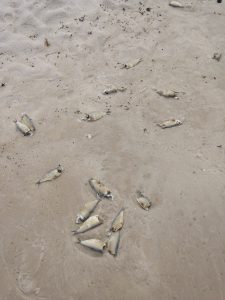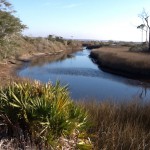Humans have inhabited the shores of Pensacola Bay for centuries. Impacts on the ecology have happened all along, but the major impacts have occurred in the latter half of the 20th century. There has been an increase in human population, an increase in development, a decrease in water clarity, a decrease in seagrasses, and a decrease in the abundance of some marine organisms – like horseshoe crabs, scallops, and some marine fishes. There has also been an increase in inorganic and organic compounds from stormwater run-off, fish kills, and health advisories due excessive nutrients and fecal bacteria in local waters.
Since the 1970’s, there have been efforts to help restore the health of the bay. Seagrasses have returned in some areas, fish kills have significantly reduced, and occasionally residents find scallops and horseshoe crabs – but there is still more to do. In this series of articles, I will present information provided in a recent publication (Lewis, et. al. 2016) and from citizen science monitoring. We will begin with an introduction to the bay itself.
The Pensacola Bay System is the fourth largest estuarine system in the state of Florida. The system includes Blackwater, Escambia, East, and Pensacola Bays. There are numerous smaller bayous, such as Indian, Mulat, and Hoffman, and three larger ones, which include Texar, Chico, and Grande. There are two lagoons that extend east and west of the pass. To the west is Big Lagoon and to the east is Santa Rosa Sound. The surface area of this bay system is about 144 mi2 and the coastline runs about 552 miles in length. There are four rivers that discharge into the system: the Escambia, Blackwater, Yellow, and East Rivers. The majority of watershed is in Alabama and covers about 7000 mi2. The mouth of the bay is located at the Pensacola Pass near Ft. Pickens and is 0.5 miles across. Depending on the source, the flush time for the entire bay has been reported between 18 and 200 days.
There are several ecosystems found within the bay system. Seagrasses are be found throughout the bay and bayous, but are more prevalent in Big Lagoon and Santa Rosa Sound. Oyster reefs have provided income for some in the East Bay area in the past, but production has declined in the last 50 years. Salt marshes are found throughout the bay as well, but the greatest acreage is in the Garcon area of Santa Rosa County. There are, of course, freshwater marshes near the mouths of the rivers with the largest being at the mouth of the Escambia River.

Members of the herring family are ones who are most often found during a fish kill triggered by hypoxia.
Photo: Madeline
Members of the drum family are one of the more common fishes found in the system and would include fish like the Spot and Atlantic Croaker. However, speckled trout, striped mullet, redfish, several species of flounder, have also been targets for local fishermen. Target fish include sardines, silversides, stingrays, pinfish, and killifish. Brown shrimp, oysters, and blue crab have historically provided a fishery for locals, but other invertebrates include several species of jellyfish, stone crabs, fiddler crabs, hermit crabs, grass shrimp, several species of snails, clams, bay squid, octopus, and even starfish. There is also a variety of benthic worms found within the sediments.

A finger of a salt marsh on Santa Rosa Island. The water here is saline, particularly during high tide. Photo: Rick O’Connor
There has been a decline in overall environmental quality since 1900 but, again, the biggest impacts have been between 1950 and 1970. Fish kills, a reduction in shrimp harvest, and hypoxia (a lack of dissolved oxygen) have all been problems.
In the articles to follow we will look deeper into specific environmental topics concerning the health of Pensacola Bay.
References
Lewis, M.J., J.T. Kirschenfeld, T. Goodhart. 2016. Environmental Quality of the Pensacola Bay System: Retrospective Review for Future Resource Management and Rehabilitation. U.S. Environmental Protection Agency. Gulf Breeze FL. EPA/600/R-16/169.
- St. Joe Red Tide Claiming Terrapins - December 15, 2025
- The 2025 Snake Watch Report for the Pensacola Bay Area - December 15, 2025
- Rattlesnakes on Our Barrier Islands; Part 2 – Prey Selection - December 15, 2025

